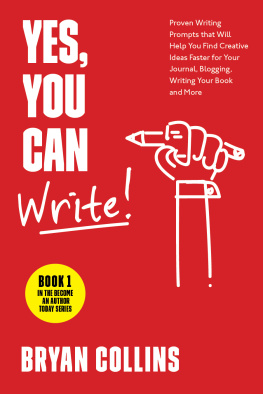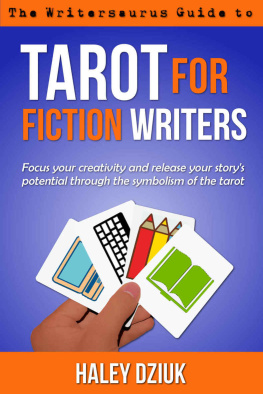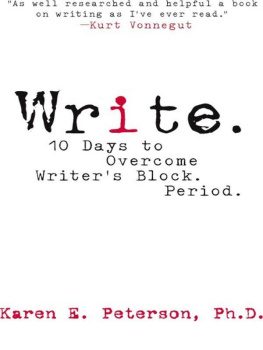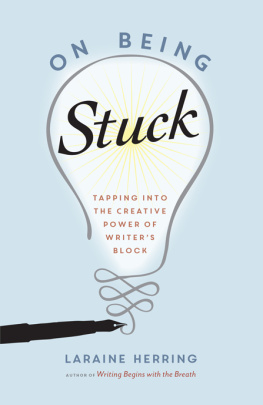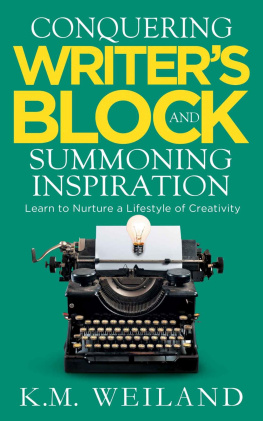5 Killer Writing Habits
You Wish You Knew
Table of Contents
Introduction
Writers block - one of the strongest enemies of creation. Next to procrastination, writers block is the most effective crusher of ideas. In procrastination, the writer knows what to write, but puts it off for later, thinking that the idea is retrievable (which, in many cases, it isnt). In writers block, however, the writer knew what to write about at the back of his mind, but something jams the signal somewhere in the brain that no matter how he tries to retrieve it, the whole idea just doesnt go through to the conscious mind. You are a writer. You know what its like: a frustrating feeling of not knowing how to write what you think, if thinking is possible at all.
Many people say that the writers block goes away when you read something. While it is true for some, it is the exact opposite for many writers around the world. For many writers, reading something while they are thinking of what to write destroys the natural flow of words. Reading makes the writers conscious of their style, critical of their morality, and even doubtful of their own meaning. Reading something else pushes the idea further into the subconscious. Whether it will ever come into full conception is a question that no one knows the answer to.
What are you supposed to do? Should you step away from your desk and do something else, until the more evil enemy, procrastination, gets a hold of you? Should you wait for another time and just hope that your Aha! moment comes soon? Or should you just write whatever, because you needed to get something done, even if your creation doesnt reflect what you really had in mind?
The answer does not lie on what you need to do to prevent the writers block, but on what you need to do get past it. Your mind is a powerhouse of ideas (they do not really run out), it is just a matter of opening the gates of your mind. Your creativity isnt something that you lose. You always have it. Its within the walls of your subconscious. All you need to do is to unlock those gates using keys. These keys are the techniques that you need to learn to open up your creative mind and get past your own writers block.
This book will give you the 5 keys to the gates of your mind. These keys are techniques that will help you unravel the beautiful ideas in your subconscious.
First Killer Technique: Chase the Images
The Hidden Ideas behind Dreams, Daydreams and the Phase Before and After Sleep
Writing starts with ideas. Many brilliant writers stay where they are, not attempting to write anything, because the idea just hasnt come to them yet. They spend hours of their day either doing other things, or staring blankly at their empty sheets of paper, not daring to stain it with ink that will not form words that will make sense. The truth is, if a writer always waits for ideas that make sense before he writes anything, then he will end up not writing anything at all.
The greatest ideas that were ever conceived did not make sense. Nikola Tesla, the greatest inventor who ever lived, got many of his ideas from vague visions that he got right before he sleeps. Edgar Allan Poe wrote his poems and short stories based on the countless dreams and nightmares he had all through his life. Salvador Dalis dreamlike paintings were results of him latching on to the visions that flashed through his eyes as he woke himself up even before he slept (more about this later).
The Beatles wrote several hit songs using images and sounds they experienced through their dreams. The most brilliant artists and creators around the world do not get their ideas from facts that make sense, but from vague, unrelated, nonsensical images that they get when they dream, day dream, and see visions before they sleep.
So here goes your first killer writing technique - chase the vague images that you see when you daydream, when you dream (have a nightmare) or when you experience hypnagogic/hypnopompic.
Step 1: When your mind wanders, let it wander until something interrupts it. Then write what you can remember in that short journey.
Do not underestimate the power of your daydreams. If you are spending some minutes just looking out the window, and then scenes started flashing through your mind, do not wake yourself up and tell yourself to stop dreaming. Daydreaming may seem like you stopped thinking for a few minutes, but in fact, your brain is very active.
According to a 2012 psychological study published on the Max Planck Institute for Human Cognitive and Brain Science, the brain activity involved in daydreaming activates peoples working memory the same type of memory used when navigating/remembering places. This means that when your mind is somewhere else, your brain is actually working in a way that it would when you are actually travelling.
This gives you great opportunities to conjure creative ideas. It is inevitable for daydreams to be interrupted, but make sure that you are not the one who stopped it. Make sure that when the scenes in your daydream stop flashing, you write down what you saw. Write down everything that you can remember without thinking of spelling or structure. If you cant put it into words, draw it.
Step 2: Record your dreams.
Keep a dream diary. The best thing about dreams is that your inner self isnt limited by concepts of morality, feasibility or impossibility. When you dream, all the images that you see are real when you are in it. You defy natural laws. You will not care about correctness. You will find the purest form of yourself, which is strongly attached to your core. Your core - thats where all the creative ideas are.
Keep a notebook by your bedside. Whenever you wake up from a dream or a nightmare, write down all the things that you can remember. Do not attempt to write with structure, for it will take time and your own brain will limit you. Write down details of your dreams in short-hand or do quick sketches of it. Make sure that you underline or highlight things or scenes that stood out.
Your dreams contain seemingly unrelated concepts that your brain tries to make sense of when you are awake. Writing down your dreams will give you a chance to look at things in a different perspective, consider possibilities that you havent thought of, and create new ideas by connecting things differently.
Step 3: Use the technique by Salvador Dali to catch the visions in your hypnagogic and hypnopompic states.
Have you ever experienced hearing some weird voices right before you go to sleep? How about seeing flashes of light or scenes right before you doze off? Dont worry, you are not going crazy. This phenomenon is called hypnagogia the transition between conscious mind and sleep.
Hypnagogia is a state of consciousness that signals the onset of sleep. Think of it as the last minute before the sun finally sets and the night begins. By itself, hypnagogia is nothing remarkable. However, many people reported seeing images and hearing sounds during their hypnagogic state. These are not ordinary people, but geniuses like Aristotle, Iamblichus , Edgar Allan Poe, Nikola Tesla and Salvador Dali. These scenes that they see right before going to sleep inspired ideas, inventions, and the most celebrated works of art.
Here are some facts about the hypnagogic state:
- Emotional and physical condition seem to trigger visual or auditory stimuli in hypnagogic state. When someone is tired, stressed, excited, anxious or depressed, the images and sounds seem clearer.
- Not everyone can remember the sounds or images that they see in their hypnagogic states, especially if they successfully fall asleep afterwards. However, those who wake up just after perceiving these stimuli are likely to remember exactly what they saw or heard.
- The sounds and images come and go quickly and do not even last more than 2 seconds.
Next page

